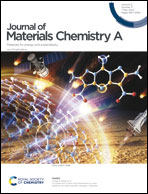Counter-anion size engineering in polyfluorene-based cathode interlayers to enhance thickness independence†
Abstract
In organic photovoltaics, a (poly [(9,9-bis(3′-(N,N-dimethylamino) propyl)-2,7-fluorene)-alt-2,7-(9,9-ioctylfluorene)]) (PFN) moiety is generally employed as a cathode interlayer material (CIM) due to its water-/alcohol-soluble properties. However, the representative PFN-based CIM, PFN-Br, has the limitation of scalable application with considerable efficiency deviation according to the cathode interlayer thickness. To enhance the thickness tolerance of the cathode interlayer, we apply a simple anion substitution of Br− with TFSI−. PFN-TFSI, containing a bulker anion (TFSI− size of 7.9 Å) than PFN-Br (Br− size of 2.0 Å), interrupts the interchain interaction, representing amorphous properties. When the thickness of the cathode interlayer is increased from 5 to 15 nm, the devices with PFN-TFSI maintain 90% of their initial efficiency without any change in the efficiency distribution. In addition, PFN-TFSI enables an extremely flat film formation even in an area of 25 cm2. This study presents that PFN-TFSI has potential to use in scalable devices.



 Please wait while we load your content...
Please wait while we load your content...